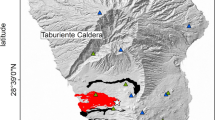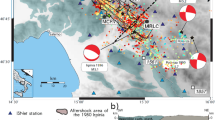Abstract
Interaction between the hydrothermal system and the axial magma chamber at a mid-ocean ridge spreading centre takes place in a boundary layer of crust that separates circulating sea water from basaltic melt1. The nature of heat flow through this region is critical because it determines the pressure–temperature conditions of the water–rock interaction and regulates the total heat flux through the system2. Here we combine seismic, thermal and chemical time-series data from high-temperature vents on the East Pacific Rise axis at 9° 50.2′ N to link a microearthquake swarm with changes measured in vent fluids. Four days after the earthquake swarm opened fractures near the base of the circulation system, a sudden increase in fluid temperature in the overlying ‘Bio9’ black-smoker vent was observed. Temperatures peaked at the vent 11 days after the swarm and gradually declined back to just above pre-swarm levels (365 °C) over the next 70 days. These observations are consistent with the Bio9 hydrothermal system tapping a previously isolated region of crust, and an upflow fluid residence time of 4 days, compared to previous lower-resolution estimates of 3 years or less3.
This is a preview of subscription content, access via your institution
Access options
Subscribe to this journal
Receive 51 print issues and online access
$199.00 per year
only $3.90 per issue
Buy this article
- Purchase on Springer Link
- Instant access to full article PDF
Prices may be subject to local taxes which are calculated during checkout



Similar content being viewed by others
References
Lowell, R. P., Rona, P. A. & von Herzen, R. P. Seafloor hydrothermal systems. J. Geophys. Res. 100, 327–352 (1995).
Lister, C. R. B. in Hydrothermal Processes at Seafloor Spreading Centers (eds Rona, P. A. et al.) 141–168 (Plenum, New York, (1983).
Kadko, D. & Moore, W. Radiochemical constraints on the crustal residence time of submarine hydrothermal fluids: Endeavour Ridge. Geochim. Cosmochim. Acta 52, 659–668 (1988).
Haymon, R. M. et al. Hydrothermal vent distribution along the East Pacific Rise crest (9° 09′-54′ N) and its relationship to magmatic and tectonic processes on fast-spreading mid-ocean ridges. Earth Planet Sci. Lett. 119, 85–101 (1993).
Rubin, K. H., Macdougall, J. D. & Perfit, M. R. 210Po-210Pb dating of recent volcanic eruptions on the sea floor. Nature 368, 841–844 (1994).
Sohn, R. A., Hildebrand, J. A. & Webb, S. C. Rift zone seismicity on the East Pacific Rise (9° 50′ N); evidence for ongoing volcanic activity. (abstr.) Eos 78, 647 (1997).
Shearer, P. M. Improving local earthquake locations using the L1 norm and waveform cross correlation: application ot the Whittier Narrows, California, aftershock sequence. J. Geophys. Res. 102, 8269–8283 (1997).
Kent, G. M., Harding, A. & Orcutt, J. A. Distribution of magma beneath the East Pacific Rise between the Clipperton Transform and the 9° 17′ N deval from forward modeling of common depth point data. J. Geophys. Res. 98, 13945–13969 (1993).
Fornari, D. J. et al. Time-series temperature measurements at high-termperature hydrothermal vents: East Pacific Rise 9° 49′ N to 9° 51′ N: monitoring dike intrusion and crustal cracking events. Earth Planet. Sci. Lett. (in the press).
von Damm, K. L. et al. Evolution of East Pacific Rise hydrothermal vent fluids following a volcanic eruption. Nature 375, 47–50 (1995).
Cherkaoui, A. S. M., Wilcock, W. S. D. & Baker, E. T. Thermal fluxes associated with the 1993 dike event on the CoAxial segment, Juan de Fuca Ridge: A model for the convective cooling of a dike. J. Geophys. Res. 102, 24887–24902 (1997).
Vera, E. E. et al. The structure of 0- to 0.2 m.y. old ocean crust 9° N on the East Pacific Rise from expanded spread profiles. J. Geophys. Res. 95, 15529–15556 (1990).
Acknowledgements
We thank L. Astiz and P. Shearer for helping to determine relative event locations for the seismic swarm; the Alvin shipboard and shore-based support group, and officers and crew of RVAtlantis-II and Atlantis for assistance in collecting the temperature data and fluid samples; and W.Wilcock, A. Rubin, S. Humphris and J. Cann for helpful comments on the manuscript. This research was supported by the US NSF.
Author information
Authors and Affiliations
Corresponding author
Rights and permissions
About this article
Cite this article
Sohn, R., Fornari, D., Von Damm, K. et al. Seismic and hydrothermal evidence for a cracking event on the East Pacific Rise crest at 9° 50′ N. Nature 396, 159–161 (1998). https://doi.org/10.1038/24146
Received:
Accepted:
Issue Date:
DOI: https://doi.org/10.1038/24146
This article is cited by
-
Geochemically induced shifts in catabolic energy yields explain past ecological changes of diffuse vents in the East Pacific Rise 9°50'N area
Geochemical Transactions (2012)
-
Hydrological response to a seafloor spreading episode on the Juan de Fuca ridge
Nature (2004)
-
Magmatic events can produce rapid changes in hydrothermal vent chemistry
Nature (2003)
Comments
By submitting a comment you agree to abide by our Terms and Community Guidelines. If you find something abusive or that does not comply with our terms or guidelines please flag it as inappropriate.



